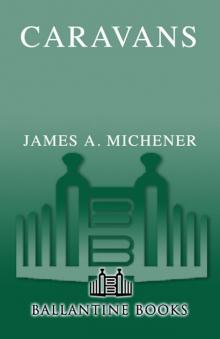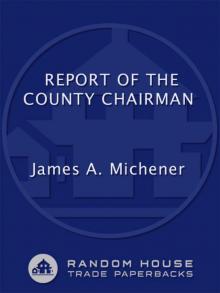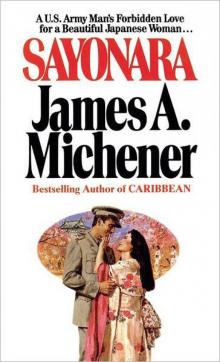- Home
- James A. Michener
Iberia Page 5
Iberia Read online
Page 5
The newspapers for sale in the plaza were a strange lot. Generalísimo Franco, the country’s dictator, was an old man and his successor had not been determined, and this was a matter which might decide the fate of Spain, but public discussion of this vital problem was forbidden, and to read the papers in Badajoz one would have felt that the general was going to live forever. I am speaking here of 1961, shortly after the inauguration of President Kennedy, when American newspapers were already speculating on what might happen in the 1964 election, and especially the 1968, but of Spain’s greater problem there was no discussion. In place of political news the papers offered reams of fine writing on sports, many columns on the Church, emphasizing the activities of the Pope, and because the men who owned the newspapers were monarchists, a constant stream of stories about how European countries that lived under kings were better off than those that didn’t.
The marriage of Prince Carlos of Bourbon to Princess Ana, daughter of the Count of Paris, was characterized by its simplicity.
Will Princess Benedicta of Denmark never find a husband? There is still hope, but available men are few and for the present she loves only horses.
Queen Isabel of England, on her forthcoming visit to Germany, will decide what shall be served at state banquets. Even though Prince Felipe of Edinburgh loves lobsters, none will be served because Isabel prefers little German sausages.
One got the feeling that the Spaniards would have enjoyed arguing politics in their papers, but it was forbidden, so they satisfied themselves with sports and religion and the doings of distant royalty.
And so it went. Badajoz was Spain, and no place else. It was sharply different from Portugal, which lay only four miles away, but it was not an exaggerated Spain, not a musical-comedy land at all.
In the morning I set out to visit random stores to see for myself what it would cost a Spaniard to live in Badajoz as compared with what I paid at home. I started by listing the dinner I’d had at the Colón:
Item Badajoz U.S.A.
First-class dinner $ 1.20 $ 4.50
Hotel room .83 14.00
Man’s shoes 8.00 10.00
Child’s schoolbag .50 1.50
Woman’s slip 1.60 4.00
Two-piece woman’s suit 30.00 75.00
Kelvinator refrigerator 235.00 160.00
Woman’s blouse 6.50 8.00
Man’s suit 37.00 75.00
Wash-and-dry shirt 8.00 6.00
Slide rule 11.50 22.50
Fine girl’s sweater 5.00 12.00
Man’s haircut .25 2.50
Calico dress 7.50 10.00
Girl’s cosmetic kit 1.30 1.50
Cheap ball-point pen .07 .29
When one considers that the average wage in Spain is sharply lower than that in the United States, these prices are on the high side, but remember that recurring costs like food and lodging are much cheaper in Spain. Also, practically anything available anywhere in the world is available in Spain. I saw Norwegian sweaters, Italian shoes, Argentinian wool, German scissors and French encyclopedias—all within a few minutes.
Consider the case of the fish market where I spent a morning talking with the proprietor and his stream of customers. It was run by Armando Olivera and stood at the busy corner of Sepúlveda and López Prudencio. At first sight it looked as if it would offer three or four kinds of inexpensive fish; in fact, it had more than thirty. Señora Gutiérrez wanted some hake, brought that morning by truck from Huelva on the Atlantic. Señora Meléndez plumped her shopping bag on the marble counter and said she wanted a bagful of backbone joints from the huge swordfish that had come from Portugal. She was making a fish stew and the joints contained much meat, but when the package was weighed and paid for, sixteen cents, Olivera chucked in an extra slice of pure meat, for which he was thanked.
At least half the fish available in this shop was frozen, much of it coming from Norway and Germany. I was surprised to see in the freezer a large selection of whole frozen chickens from Denmark, butter from Ireland and frozen meat pies from England, all at prices sharply lower than they would have been in America.
Spain makes it easy for the foreigner to convert his dollars into pesetas. In even the smallest town, if it has a bank, one can cash his traveler’s checks with ease. In Badajoz there were, I judged, about fifteen banks or offices which performed this service. I used the Banco Mercantil, the exterior of whose building had impressed me during my survey of the plaza. Inside, it was as brisk and bright as a new branch bank in Omaha and much more so than one in Glasgow. I presented my check and passport to a young man, who greeted me in English. In less than a minute he typed out slip #453, handed half to me and passed the other half along to three different officials, who initialed it and handed it to the teller, a very busy man. I waited in a long line while the teller dealt with slips #440 to 452. Finally he called, ‘Cuatro cientos cincuenta y tres.’ I presented my matching half of the slip and he counted out the money. ‘We are pleased to have you in Spain,’ he said in Spanish.
Afoot, on bicycle or on horseback, officers of the Guardia Civil in pairs move back and forth across Spain.
I was eager to find out what an average day for a Spanish businessman consisted of, and on one of my walks I came upon the Casino de Badajoz, a distinguished men’s club whose broad plate-glass windows, fronting on the main street, were always occupied by gentlemen who seemed to do nothing but ogle the passing girls. Without any kind of introduction I entered the club and explained my problem to the majordomo, who grasped the situation at once, offered me a beer and summoned a club official, a delightful talker whose monologue I shall repeat as he gave it:
‘This club is the heart of Badajoz. Very old, very honorable. It costs thirty dollars to join and twenty dollars a year dues, but the waiting list is so long you’d not have a chance right now. As a foreign visitor, however, you would be most welcome on a temporary basis. On the second floor, the big television room. Next to it our enormous ballroom. These red and white furnishings, the mirrors, the red plush boxes, the stucco figures on the ceiling … we think these lend a touch of elegance. I don’t know who carved that “Venus Holding a Mirror” or the huge “Judgment of Paris,” but they’re old and familiar and lend a sense of permanence. We have four floors here, all marble, a barbershop, billiards. At the green tables in this game room a lot of money has been won and lost. The bar, the library. We get papers from all over Spain and Paris too. Our restaurant used to do a large trade, now the snack room does more. We offer much to attract children and in the evening women are welcomed too. But, as you can guess, it’s that big front room that establishes the quality of the club. In the course of a week you’ll see in this room all the men who run Badajoz. You might almost say Extremadura. Even the soldiers and the priests you’ll see here. It is marble, has those five impressive front windows, the big comfortable leather chairs. The large painting shows a country wooing. I think the man is playing an oboe. But this is the heart of the club. This is the room that means more than home to the men of Badajoz.
‘No, the man you ask about is not from Badajoz. You see, each city in Spain has one top club like this, and if you belong to it in your home town, you automatically have privileges in all the others. The man you’re looking at is from Sevilla.
‘You want to know what the average day of a club member is? You must remember that these are well-to-do men, the leaders of Badajoz, and this is an agricultural region. So your average man would have to be a farmer. Let’s take that one in the big chair, staring out the window. His name is … we’ll call him Señor Don Pedro Pérez Montilla. He lives about twenty miles south of here. Has one large plantation of cork trees, another where he grows wheat, some pigs and sheep. About two thousand acres altogether. Has three cars. An English Land Rover to get about the plantation, a Spanish SEAT 1500 for his own driving and a SEAT 600 for the rest of his family. Of course, he never drives himself. Has a driver who does that. He must rise rather early, for in the morning, after breakfast of
a roll, some coffee and a glass of anís (anisette), he supervises his farms. But every day he reaches this club not later than twelve-thirty. Plays dominoes in the back room. Talks with his friends. About two-thirty in the afternoon he drives back to his farm, makes his lunch on soup, eggs and potatoes, meat and fruit and takes his siesta. He’s back at the club by six-thirty and always sits in the chair you see him in now.
‘At that time he’s joined by three other men, whom he’s known for forty years. They form what we call a tertulia. That’s an informal club that meets every day to gossip. What about? Don Pedro’s tertulia are all farmers, so they talk about cork and olives and sheep and whether a Land Rover is better than a Jeep. Yes, every day for forty years that’s what they’ve talked about. Politics not very often. Religion never, because all four men in the tertulia know what the others think on those subjects. Sometimes no one speaks for forty minutes. When that happens they all look out the window at the pretty girls in the paseo. The tertulia meets in those four chairs till about ten at night, when Don Pedro drives back to the farm for his dinner of consommé and tortilla [in Mexico, a flat unleavened bread of maize; in Spain, a potato omelet]. A man like Don Pedro would never eat in a restaurant, but one night four years ago he did invite a guest to the farm for dinner.
‘Don Pedro reads the ABC each morning, but nothing else. He goes to the movies only when they show Gary Cooper or John Wayne. He has two fine daughters who went for a while to the convent school, but now they’re waiting for someone to marry them. Don Pedro would probably not allow them to marry a man whose family did not belong to our club. Otherwise where would the new family fit in?’
A word about Spanish names. To explain the tradition fully would require many pages, for it is unbelievably complicated, but ideally every Spaniard, male or female, has two surnames, the first and more important being the father’s and the second the mother’s. Thus Pedro Pérez Montilla can properly be referred to as Señor Pérez Montilla or simply as Señor Pérez, but to refer to him as Señor Montilla would be a real gaffe. Spanish also has the handy little words Don and Doña, which have no equivalent in English and cannot be translated; they are used only preceding a given name, allowing one to refer to a man or woman by the given name with no presumption of intimacy. Thus our friend can be called Don Pedro or Señor Don Pedro Pérez Montilla. When he married, let. us say to Leocadia Blanco Alvarez, his wife did not surrender her surnames but merely added his, preceded by the preposition de (of), so that her name became Leocadia Blanco Alvarez de Pérez Montilla, and she may properly be addressed as Doña Leocadia, or as Señora Blanco, or as Señora Blanco Alvarez, or as Señora Blanco Alvarez de Pérez Montilla, or as Señora de Pérez Montilla. Frequently the paternal and maternal surnames are joined by either a hyphen or an y (and), which means that Don Pedro’s son could be named Antonio Pérez Blanco, or Antonio Pérez-Blanco, or Antonio Pérez y Blanco, although in recent years the last has become less frequent. Many Spaniards today, in common usage, simply omit the maternal surname entirely or abbreviate it to a single letter. On the other hand, if Don Pedro and Doña Leocadia belong to the nobility or the aristocracy (or if they want to put on airs) the son will adopt the name Señor Don Antonio Pérez Montilla y Blanco Alvarez.
The problem is further complicated when a man has a family name which is. unusually common and a maternal name which is less so, for then he becomes known by the more distinctive of his two names, which is only sensible. The five most common Spanish surnames, in order of frequency, are García, Fernández, López, González and Rodríguez, and just as the Englishman named Smith or Jones is accustomed to adding a hyphenated second name, such as Smith-Robertson, so the Spaniard becomes García Montilla, sometimes with the hyphen. It is in conformity with this custom that the great Spanish poet Federico García Lorca is so often referred to simply by his maternal name. Anglo-Saxon readers encounter difficulties with the names of such historical figures as Spain’s two cardinals who exercised political leadership, Mendoza and Cisneros; in history books you will find many pages about them, and they were at least as famous as Richelieu in France and Wolsey in England, yet if you try to look them up in a Spanish encyclopedia you will find nothing unless you happen to know that the former was born Pedro González de Mendoza and the latter Gonzalo Jiménez de Cisneros. In each of these instances, however, the distinctive name is not maternal but merely a place name added in hopes of making a common name distinctive. So far I have discussed only the simple cases; the complicated ones I had better skip.
In a small Spanish city to which a friend had sent me a postal money order I had a rueful introduction to this problem of names. My friend had assured me by phone that the money had been sent, and the post office had advised me that it had arrived and that upon presentation of my passport it would be paid. Accordingly, I went to the post office, but before telling the clerk my name, handed him my passport. He studied it, consulted his file of incoming money orders and said, ‘Nothing here.’ I explained that I knew it was in hand, so with much politeness he searched his papers again and said, ‘Nothing here.’ This time I noticed that he was looking in the A file, so I suggested, ‘Perhaps if you look in the …’
‘Please, Señor Albert,’ he said. ‘I know my business.’
In my passport he had seen that my name was James Albert Michener and he was smart enough to know from that who I was, and he had no cash for any Señor Albert. When I tried to explain what my name really was he became angry, and I was not able to get my money until Spanish friends came from the hotel to the post office and explained who I was. When the money was paid, the clerk took my passport again, studied my name and shook his head. When he handed back my papers he said, ‘I am sorry for your inconvenience, Señor Albert.’
The nightly paseo which Don Pedro watches from his window is common to most Spanish cities, but in Badajoz it has special features because the city has not one main plaza but two. Plaza San Juan, which faces the cathedral, we’ve seen, but Plaza Generalísimo Franco, the larger of the two, we have not. They are connected by the street that runs past the big windows of Don Pedro’s Casino de Badajoz, so that what in other cities is called ‘a turn about the plaza’ becomes in Badajoz a substantial march: back and forth along Plaza San Juan, down the long street past the Casino, then around the Plaza Franco, where band concerts are held from eight to ten.
Badajoz, as seen from this latter plaza at night, is a delightful city. ‘These gardens are for all and are to be cared for by all,’ states a large sign beneath which iron tables are set out for groups of eight or ten teen-agers. Nursemaids in starched uniforms parade up and down with infants in carriages, and a host of children under six play among the trees till midnight. ‘They’ve been taking a siesta all afternoon,’ a mother explains. At the corners of the park semicircular benches made of bright tile are occupied by soldiers and their dates, while at the tables along the outer edges men sit in groups talking about the same topics that are being discussed in the Casino. At ten-thirty or eleven the older people wander home for dinner, and the long day ends.
In all but one of the cities discussed in this book I will be drawing upon recollections of more than one visit. I have been to Badajoz four different times, to Madrid about twenty, to Sevilla a dozen, to Teruel two; it was not until my last visit to Spain that I saw Barcelona for the first time. Of the various things I was to see in Badajoz, I think the most meaningful occurred during my first visit when I was standing idly in Plaza Franco toward midnight as the stragglers were heading home. A married couple named Serrano were seated at the table next to mine and as I rose to go back to my hotel the man said, ‘You’re not going to miss the cathedral?’ I asked why not, and he said, ‘Because it’s May 13.’ I asked what was special about that date, and he said, ‘Come and see.’
We walked back to the Cathedral, where families were entering the ugly main portal accompanied by more than a hundred young people. I entered the dark interior; little boys in robes were handing out lighted
candles that produced marvelous shadows across the low-vaulted ceiling. The interior of the cathedral was even more depressing visually than the exterior, for late in the life of the church some enthusiastic canon had built a choir and plastered its walls with a cheap stucco that was supposed to look like cut stone. The four bottom rows were painted a dirty beige, the nine top, a sickly puce. But spiritually the interior had the same bold force that I had observed in the cathedral as a whole; I was inside a great fortress which contained no nonsense or embellishment. In time of peace worshipers came here to pray; in time of war to defend themselves.
At midnight bells tolled and five dignitaries of the church in full regalia conducted a service which I could not understand. ‘It’s not a mass,’ the Serranos told me. ‘It’s an invocation to the Virgin.’ There was a moment of silence as the hundreds of candles flickered, and then Señor Serrano whispered, ‘It’s May 13. The Virgin of Fátima. We’re very close to Portugal, you know.’
When the praying stopped I assumed that the services were over, but they were just beginning, for now a procession formed at the altar and left the cathedral, entering the dark city, and all who bore candles fell in line and began a solemn march down Calle del Obispo San Juan de Ribera, through the silent Plaza Franco and out into the suburbs lying to the northwest. The procession consisted of some four or five hundred worshipers, perhaps as many as a thousand, for it stretched a long distance. At the head marched a priest with an electronic bullhorn, through which he sang endlessly in a husky voice,

 Mexico
Mexico The World Is My Home: A Memoir
The World Is My Home: A Memoir Sayonara
Sayonara Chesapeake
Chesapeake The Novel
The Novel Rascals in Paradise
Rascals in Paradise Return to Paradise
Return to Paradise Presidential Lottery: The Reckless Gamble in Our Electoral System
Presidential Lottery: The Reckless Gamble in Our Electoral System The Source
The Source Poland
Poland Space
Space Caravans
Caravans Creatures of the Kingdom: Stories of Animals and Nature
Creatures of the Kingdom: Stories of Animals and Nature Iberia
Iberia Hawaii
Hawaii The Watermen: Selections From Chesapeake
The Watermen: Selections From Chesapeake Report of the County Chairman
Report of the County Chairman The Covenant
The Covenant The Bridges at Toko-ri
The Bridges at Toko-ri Matecumbe
Matecumbe Journey: A Novel
Journey: A Novel Centennial
Centennial Sports in America
Sports in America Texas
Texas Miracle in Seville
Miracle in Seville This Noble Land: My Vision for America
This Noble Land: My Vision for America Tales of the South Pacific
Tales of the South Pacific Bridges at Toko-Ri
Bridges at Toko-Ri Space: A Novel
Space: A Novel Presidential Lottery
Presidential Lottery Sayonara: A Novel
Sayonara: A Novel This Noble Land
This Noble Land The Covenant: A Novel
The Covenant: A Novel Miracle in Seville: A Novel
Miracle in Seville: A Novel The Bridge at Andau
The Bridge at Andau Source
Source The Source: A Novel
The Source: A Novel Journey
Journey Recessional: A Novel
Recessional: A Novel Legacy: A Novel
Legacy: A Novel The Bridges at Toko-Ri: A Novel
The Bridges at Toko-Ri: A Novel Poland: A Novel
Poland: A Novel